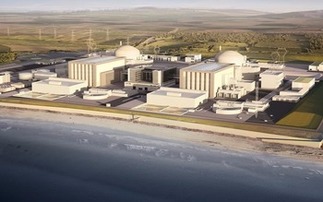Pembroke gas power station is one of the UK's biggest emitting sites
Trading of carbon allowances on UK's post-Brexit carbon market begin today with prices initially above those on the EU's ETS
The UK carbon price exceeded £50 per tonne this morning as trading on the new post-Brexit domestic Emissions Trading Scheme (ETS) began for the first time today, signalling significant costs may lie ahead for major polluters in Britain that fail to curb their emissions.
Set up as a replacement for the UK's participation in the European Union's ETS, which came to an end in January as part of the UK's exit from the EU, the UK's domestic ETS is regarded as a key measure for decarbonising large power plants, heavy industry and aircraft, enabling operators to trade CO2 allowances within an overall cap.
The UK's ETS covers the emissions of roughly 1,000 energy intensive industries and power stations and around 140 UK-administered aircraft operators, and by raising the costs of emitting greenhouse gases, it is hoped operators will be incentivised to invest in decarbonisation efforts.
Ahead of the first auctions of allowances today, the government has said its aim is for the long-awaited ETS to be the world's first ever net zero-consistent cap and trade market.
Energy Minister Anne-Marie Trevelyan hailed the first auction for the UK's ETS as "a major milestone" in delivering on climate goals and supporting businesses to cost-effectively decarbonise.
"At every step of the way, we will protect the competitiveness of British industry and minimise risk of carbon leakage as we transition to a green economy," she promised. "Our UK ETS is more ambitious than the EU system it replaces and with today just the start of regular auctions, we are one step closer in our ambition to have the world's first net zero carbon cap and trade market."
ICE Futures Europe, which has been contracted to oversee the market and host the auctions, confirmed that carbon allowances on the UK's ETS opened for trading at £50.23 this morning, before falling back down slightly, with trading at around £47.11 as of 11.30am.
The price is therefore above a minimum threshold set by the government of £44.74 per tonne for the new carbon market, which if the price falls below on average over the coming months will trigger a Cost Containment Mechanism (CCM) that is designed to address any over or undersupply of allowances and calm any instability in the market. The market also has a floor price of £22 per tonne.
Should the UK carbon price consstently surpass a level of around £50 per tonne, it would put the market on a similar trajectory to the EU's, which has seen prices surge to similar record levels in recent weeks, thereby hiking costs for major polluters.
In order to drive a rapid acceleration away from fossil fuels towards net zero in line with the goals of the Paris Agreement, experts have previously estimated the price of emitting CO2 may need to reach at least around $100 per tonne worldwide before the end of the decade.
Yesterday, however, the Bank of England's Sarah Breeden - who, as executive director for UK deposit takers supervision, oversees the Bank's climate risk work - said a suite of policies worldwide would need to take the global carbon price to around $150 per tonne by 2030 in order to keep the chances of limiting global warming to 1.5C within reach. She said her estimates were based on research by the Network for Greening the Financial System (NGFS), a group of 89 central banks and supervisors around the world.
Earlier this month the EU carbon price topped €50 per tonne for the first time, with tightening climate policies and growing demand from investors having seen EU allowances become one of the world's best performing commodities in recent years. As recently as December, EU carbon allowances were trading at around €30 per tonne.
But earlier today carbon allowances on the EU's ETS - which is also hosted by ICE - were trading at slightly lower than in the UK, with the price sitting at around €52.40 per tonne, which is equivalent to £45.25 per tonne.
Jonathan Marshall, head of analysis at the Energy and Climate Intelligence Unit (ECIU) think tank, said that the first UK emissions auction clearing close to EU prices would "bring a sigh of relief for industry and policy makers".
"A smaller market and uncertainty about interventions to curb price spikes brought pre-auction worry that the permit prices would soar above those on the mainland and be volatile - potentially damaging the efficacy of carbon trading as a means of cutting carbon," he said. "Clearing this first hurdle means attention can be turned to the future, taking decisive action to end free permits that undermine the whole purpose of carbon pricing, setting a net zero-aligned trajectory and thoroughly assessing a link with the EU scheme. The government has made it clear that it wants carbon pricing to be part of the journey to net zero, this is the opportunity to make that happen."
The UK has said it plans to auction around 83 million carbon allowances in 2021, with further auctions scheduled to take place throughout the year. A consultation is expected "in due course" on aligning the supply of allowances with the UK's 2050 net zero target.
The government is also exploring the potential to expand carbon pricing right across the economy to the additional two-thirds of emissions not currently covered by the ETS, and has previously indicated it is open to linking the UK's market with that of the EU's in future.
However, concerns remain that the overall cap on CO2 may be too high at present to effectively drive down emissions in line with a net zero emission decarbonisation trajectory.
Environmental lawyer at Pinsent Masons, Fiona Ross, said "all eyes will be on how [UK] prices compare against EU allowances". "The government has indicated it will consult on aligning the cap under the UK ETS with its net zero trajectory over the coming years, but amidst an ongoing court case arguing that the cap is set too high to drive down actual emissions, it remains to be seen whether the price will reflect the UK's ambition in this area," she said. "The government has put in place a mechanism to deal with sustained high pricing and volatility, allowing it to intervene in a range of ways, but only the auction reserve price protects against low pricing."
Elsewhere, concerns have also been raised that carbon intensive companies such as steel producers may be put at a significant competitive disadvantage compared to producers outside the UK and the EU that are not governed by carbon pricing. Policymakers in Westminster and Brussels are continuing to debate whether to try and introduce tariffs to combat this risk of so-called 'carbon leakage' and deliver a level playing field for carbon intensive companies operating under carbon pricing regimes.
However, Louis Burford, head of solution sales and optimisation at Centrica Business Solutions, urged all businesses to consider how they could take steps to curb their emissions and reduce costs in the face of carbon prices that are expected to keep climbing in the coming years. "Businesses will be debating how much of their requirement they should buy now and how much they should defer to a later date," he explained. "One thing that's clear is that carbon prices are growing, and it's a cost that impacts almost all businesses. For those looking to reduce their carbon emissions or become net zero, there are technologies and services that can help. By taking the cost of carbon off the books altogether, firms can avoid the market and hedging bets on how high carbon prices will go."
Carbon prices in both the UK and EU are already at record levels, but if all goes to plan plenty more records will be set in the coming years as the ETS cap falls and prices rise. Savvy businesses will recognise the business case for investment in emission reduction measures is only going to get stronger.

 19 May 2021
•
7 min read
19 May 2021
•
7 min read












